Here are sights and sounds from the Amazonas rain forest, cloud forest in the Andes, and the far-flung volcanic Galapagos Islands in the Pacific:
Images of Ecuador and the Galapagos Islands
Ecuador Posted on 26 Jul, 2018 08:53- Comments(0) https://travels.insidestory.dk/?p=12
8 – Final thoughts and photos
Ecuador Posted on 24 Apr, 2018 20:27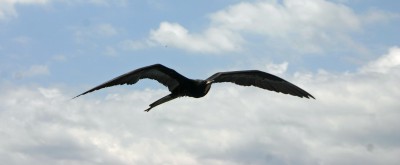

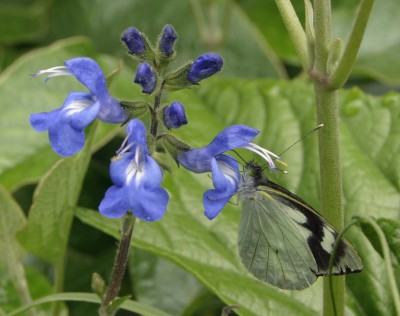

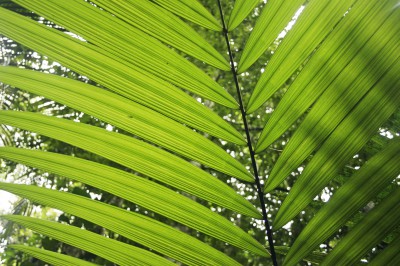
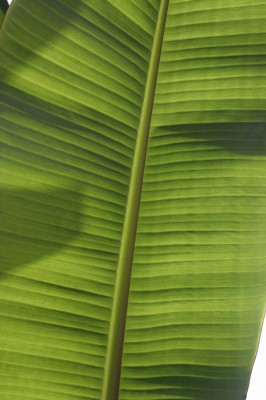 Ecuador has so much to offer: incredible biodiversity,
Ecuador has so much to offer: incredible biodiversity,
rainforest, cloud forest, mountains, beaches, far-flung islands with unique
animal and plant species and balmy weather in addition to good food (like
roasted guinea pig – yum!) and nice people. Just think – I have seen 119
different bird species in the space of two weeks not to speak of snakes, frogs,
lizards, iguanas, insects and land and sea mammals. What a treat!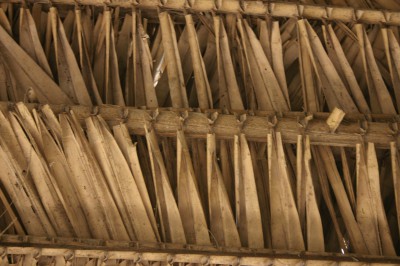
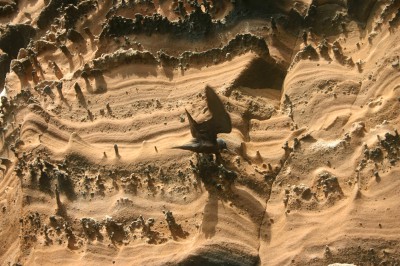
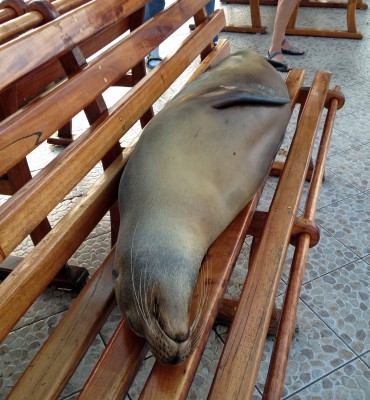
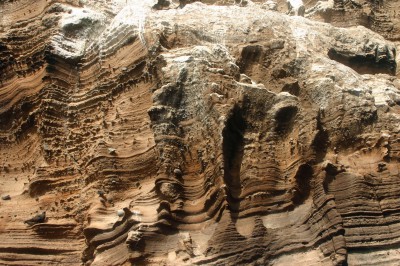
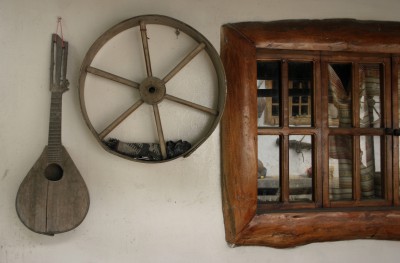
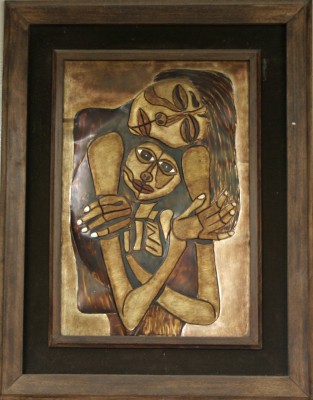 It is a gift to visit such a biologically diverse
It is a gift to visit such a biologically diverse
country. People from urbanized, intensely cultivated or just generally
environmentally depleted places should have a taste of this so they know what they
are missing and understand why nature conservation is important. This world has
already lost so many species and is making life difficult for those that remain.
Do we really want coming generations to inherit a world where farm animals,
pets, crows and ants are all that are left?
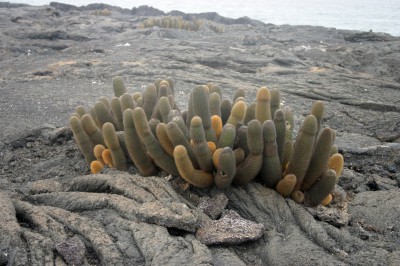


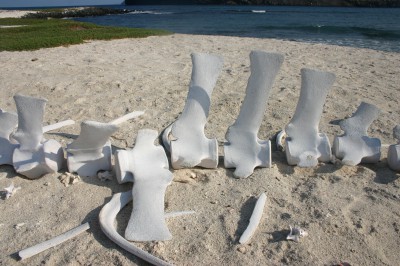 Surely, we can find ways to combine nature,
Surely, we can find ways to combine nature,
agriculture and urbanisation without making a mess of all of them. With those
words I will leave you to enjoy the last of my photos and thank you for
following me this far.
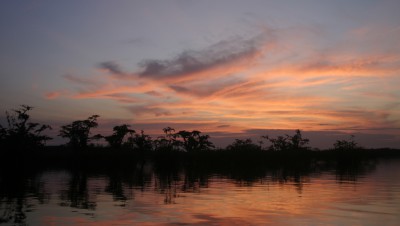
- Comments(0) https://travels.insidestory.dk/?p=13
7 – Intriguing islands: Galapagos
Ecuador Posted on 22 Apr, 2018 17:57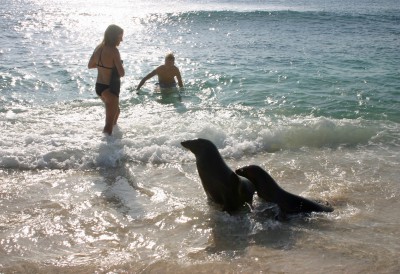
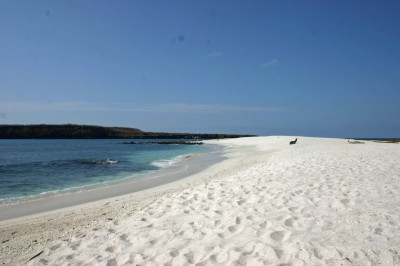 Ever since reading about Darwin’s journey to the Galapagos
Ever since reading about Darwin’s journey to the Galapagos
Islands on the HMS Beagle I have dreamed of going there myself. Dreams are good
to have; they keep you afloat in a mundane world. But dreams turn to dust if
you don’t realise them, so after some years of dreaming and planning and saving
money, the time has come to make my dream come true and travel to these
intriguing islands. 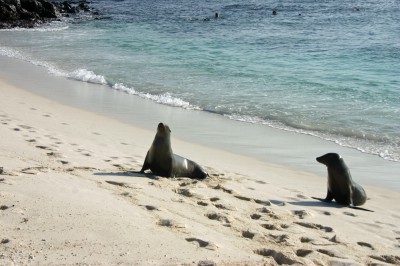 Each island has its own character and its own
Each island has its own character and its own
complement of endemic species. We alternately experience fine-grained white
sandy beaches populated by friendly, easy-going sea lions that seem intent on
making our acquaintance, otherworldly, rough and uneven charcoal-coloured lava
landscapes with ditto-coloured iguanas and lizards, dramatic seascapes with
waves that crash against the cliffs, making us feel small and insignificant,
and fragrant woods that overlook the stunning, saline Lake Darwin on Isabela
Island.
Here is a lava landscape:
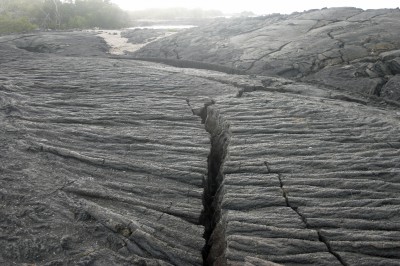 And here are lava-coloured, endemic marine iguanas piled on top of each other. They have a rather disconcerting habit of shooting snot out of their noses. So impolite! But that is their way of getting rid of excess salt from their algae diet:
And here are lava-coloured, endemic marine iguanas piled on top of each other. They have a rather disconcerting habit of shooting snot out of their noses. So impolite! But that is their way of getting rid of excess salt from their algae diet: One one island the surf pounds against the rocks:
One one island the surf pounds against the rocks: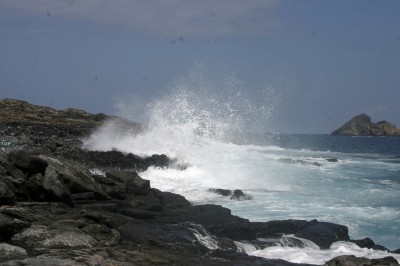 While on another island the scene is more serene:
While on another island the scene is more serene: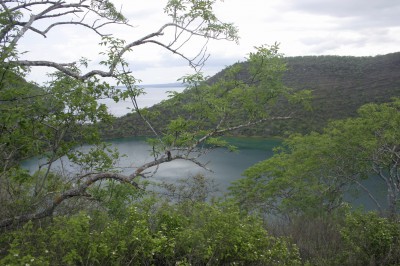 There are birds and other interesting creatures
There are birds and other interesting creatures
everywhere.  Already at the airport, on Baltra Island, we spot our first
Already at the airport, on Baltra Island, we spot our first
blue-footed boobies and frigate birds. In the days that follow, we walk among
land iguanas, marine iguanas, Galapagos tortoises, lava lizards, sea lions, sally
lightfoot crabs, Galapagos finches and fur seals.
Here is a blue footed booby showing off its tail:  And here is a Galapagos penguin with an iguana buddy:
And here is a Galapagos penguin with an iguana buddy: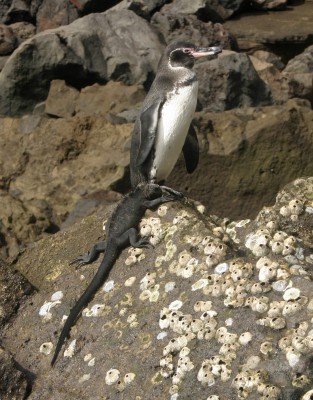 The penguin prepares for a hop in the ocean:
The penguin prepares for a hop in the ocean: 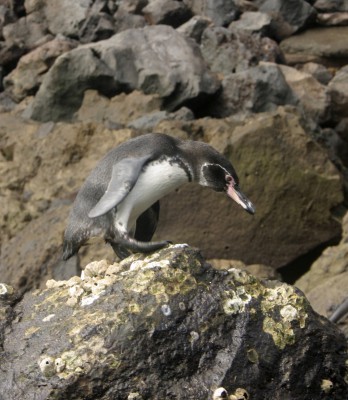 Flightless cormorants have evolved short, useless, silly looking wings but still spread them out like other cormorants:
Flightless cormorants have evolved short, useless, silly looking wings but still spread them out like other cormorants: 

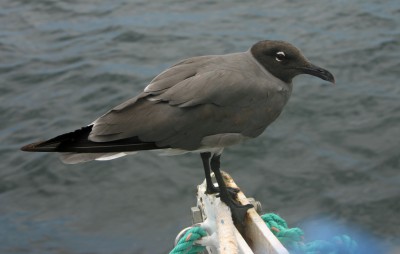 Chilling out on the beach:
Chilling out on the beach: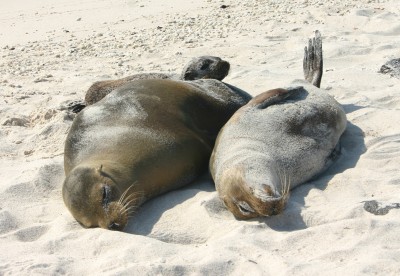 Chilling out on a rock:
Chilling out on a rock:  Chilling out in a little pool:
Chilling out in a little pool:  Male and female grasshoppers having a private moment:
Male and female grasshoppers having a private moment: 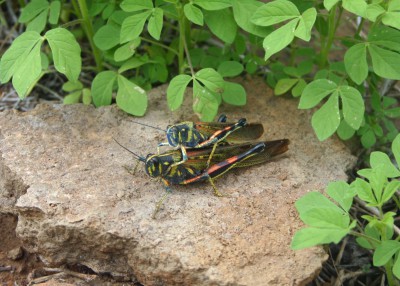 The land iguana Mona Lisa smile:
The land iguana Mona Lisa smile:  Sunfish swim alongside our rubber boat (panga) and manta
Sunfish swim alongside our rubber boat (panga) and manta
rays breach the water in the distance. At
times we jump in and join the animals and snorkel either from the beach (I get rolled around rather much in the surf before getting control of my flippered and snorkeled body…) or slide from the panga out into the deeper water.
While snorkeling, I am accompanied by Galapagos penguins,
sea lions, marine iguanas, green turtles, stingrays, a harmless black-tipped
shark and numerous shimmering or colourful fish, all of whom are completely
unperturbed by my presence. In fact, it is as if they are inviting me to join
in their swim.
At one point, however, I can hear our local guide
yelling “shark!” My flippered feet paddle furiously and I zip through the water
like a penguin until I reach the panga and quickly clamber up to safety. It
turns out that it was not a shark but an orca. Even more scary! There is no
mistaking this beautiful animal with its big, sleek, black and white body. It
swims alongside our panga and even under it at one point as we carefully escort
it further out of the bay towards the open ocean. Afterwards, we jump back into
the water by the beach and continue snorkeling.
The land animals are not used to predators so they do
not dash off when they see us. It is fascinating to be in such close contact to
all these endemic animals, some of which are even endemic to a specific island. The giant Galapagos tortoises are an example of such:  It is also fascinating for me to consider that a
It is also fascinating for me to consider that a
little less than a year ago I was in a boat navigating among icebergs on the
Arctic Circle and now I am in a boat – or swimming directly in the water – navigating
among fish and mammals on the Equator. I am such a lucky girl!
- Comments(0) https://travels.insidestory.dk/?p=14
6 – Food and fabrics: An orgy of colour
Ecuador Posted on 12 Apr, 2018 18:12It was not my intention – it just kind of happened –
crossing the equator in all three of the continents that the equator runs
through. First in Africa (Kenya and Uganda), then in Asia (Borneo) and now in South
America (Ecuador). 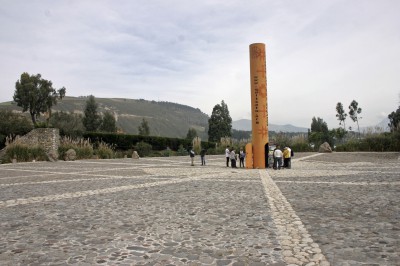 We also pass through a town where everybody bakes biscuits and we of course visit one of the bakeries
We also pass through a town where everybody bakes biscuits and we of course visit one of the bakeries
and taste the goods – which are good – and pass by the extinct
volcano Cayambe with its iconic cone shape. At 4600 m, it is the highest
point in the world through which the equator passes and the third highest peak
in Ecuador. 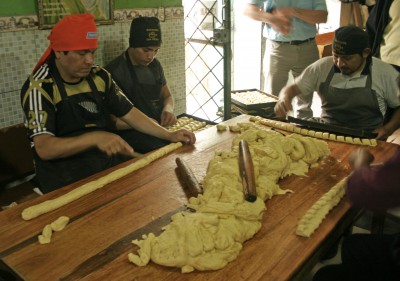
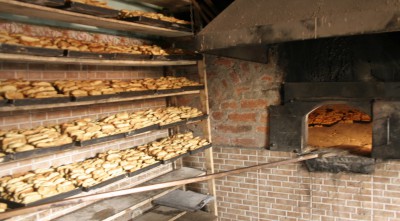
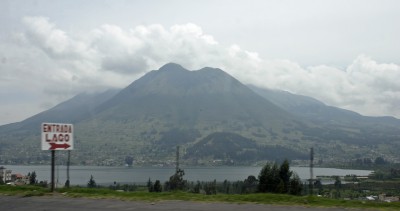 Otherwise, the highlight of the day is the market at Otavalo.
Otherwise, the highlight of the day is the market at Otavalo.
It is one of the most important indigenous markets in the Andes. Food and
fabrics are for sale in different locations and both are an orgy of colour. The
food market has rows upon rows of stalls selling a huge variety of fruits,
berries, vegetables, beans, pulses, rice, grains, fish, chicken, meat and
roses, of all things. It turns out that Ecuador is the world’s third largest
exporter of cut flowers, including roses. 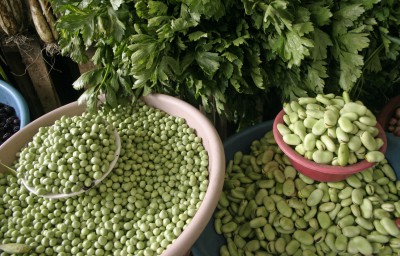



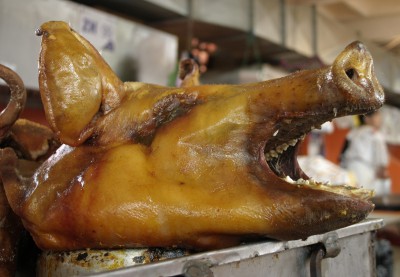
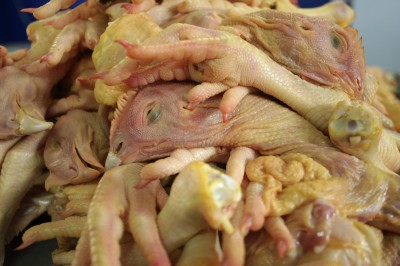

Some of the food products are unrecognizable to me
and, once again, I regret that I do not speak Spanish well enough to ask the
tradesmen and women what they are selling. Being able to strike up a
conversation is one of the best ways I know to get to know people well enough
to get permission to take their picture. As it is, less than a handful indicate
that they are willing to be photographed, so most of my people pictures are of
people’s backs. It is such a shame because many of the people are dressed in
their traditional outfits. 
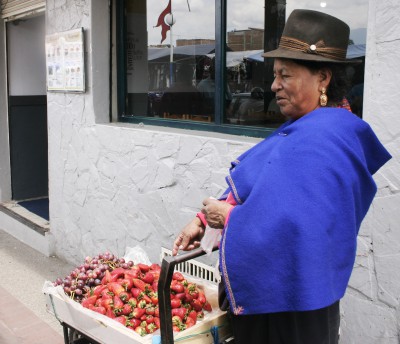 Anyway, I go from the appetising and colorful food and
Anyway, I go from the appetising and colorful food and
flower market to the even more vibrant hues of the textile market. Here you can
buy blankets, hammocks, blouses, scarves, tablecloths, shawls, ponchos,
sweaters, pillow covers and much more – all of it in bright but not gaudy
colours and oh so soft alpaca wool.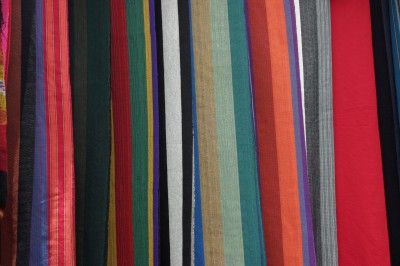


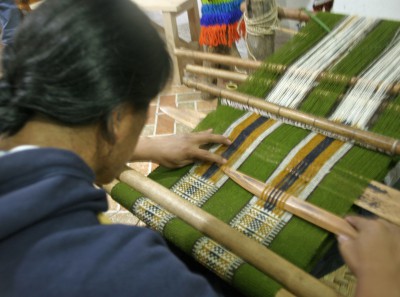
- Comments(0) https://travels.insidestory.dk/?p=15
5 – Getting high in the Andes
Ecuador Posted on 10 Apr, 2018 18:17I regret having to leave the lush, biodiverse
rainforest. If I had an extra life or two, I think I might like to be an
ethnobotanist and study the relations between plants and humans – and what more
exciting place to do that than in a rainforest?
Admittedly, the Amazonas rainforest is hot and sticky,
so on that level it is a relief that the next item on our agenda is a drive up
towards the Andes Mountains to a cloud forest – and to a place that is even
more magical. 
I have never been in the Andes mountain range before,
so this is a new high for me. 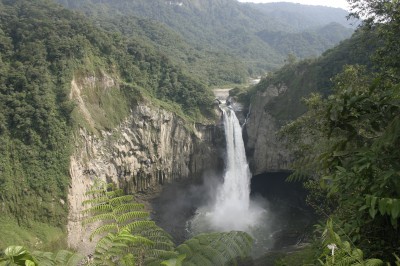
On the way, we pass an impressive waterfall, but the
highlight is, of course the cloud forest, where we stay for a few days at the
amazing Cabañas San Isidro located at 2000 m
above sea level about a two-hour drive from Quito and close to the town of
Baeza. 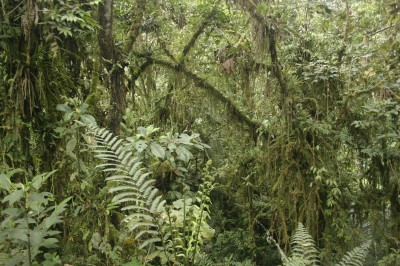
I can recommend this place for its commendable
ecological awareness, tasty food, pleasant accommodations, gorgeous views in
every direction, incredible biodiversity and easy accessibility. The climate is
good, too, with warm days and cool nights – everything is just perfect! 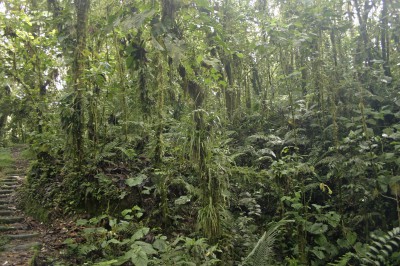
We go for guided walks and see various tiny frogs,
footprints from tapir and ocelet, and numerous bird species that are new to us
and that we did not see in the rainforest – notably a wide array of
hummingbirds. 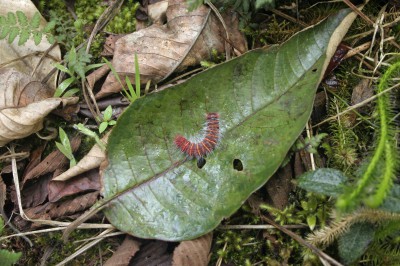

Some of the hummingbirds flash different bright
colours depending on how the sun hits them, some of them have long, elegant
tails, some are aggressive (to each other)
and some are just plain cute. I could spend hours watching these
intriguing little birds.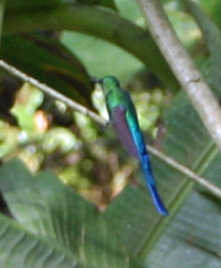

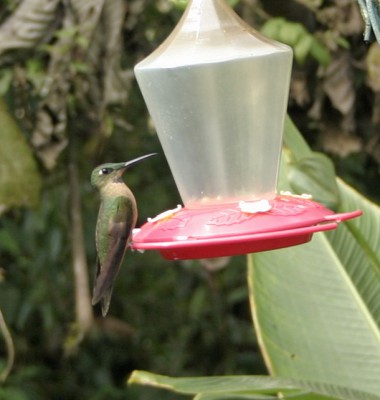

Other fun things that we see are the curious and
colourful Inca jay and a very special owl. The owl is called Mystery San Isidro
Owl and is only found in this particular spot. 
It is with even more regret that I say goodbye to this
place, but we must go onwards and upwards. We travel further up in the Andes
and stop for a cup of yummy Ecuadorian hot chocolate at a place where there are
yet more new hummingbird species to watch, including glowing puffleg that
shines green on its back and has cheerleader pompoms on its tiny legs (not the one in the photos below).
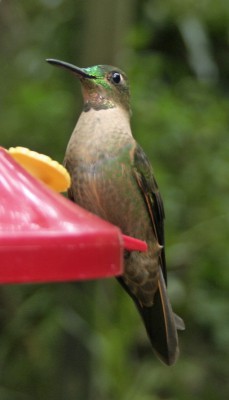
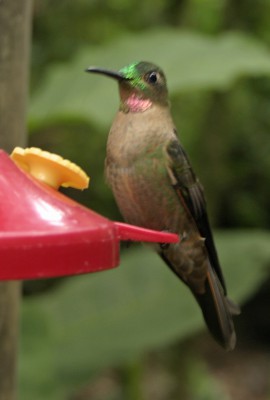
Next stop is a pure wellness experience: the thermal
baths at Papallacta at 3120 m above sea level. We loll around in the various
pools whose water temperatures range from dishwasher hot to bathtub warm to icy
cold (fed from the nearby stream) while the air is nice and cool. I switch from
the very hot to the very cold a couple of times and find it quite refreshing.
Squeaky clean, totally relaxed and rather sunburned we
continue through the mountain landscape to a pass – our highest point at 4000
and something metres above sea level. We scan the sky for the iconic Andean
condor, but unfortunately do not see any. However, we do see the rump of a
white-tailed Andean deer.

- Comments(0) https://travels.insidestory.dk/?p=16
4 – Farming Amazonas style
Ecuador Posted on 08 Apr, 2018 21:17 On one of our days in the Cuyabeno Reserve we visit
On one of our days in the Cuyabeno Reserve we visit
the local village Puerto Bolivar, where Siona people live. They farm, fish and
invite tourists to visit them. The village is neat and tidy with flush toilets,
running water, and recycling bins. Indeed, that seems to be the order of the
day all over Ecuador.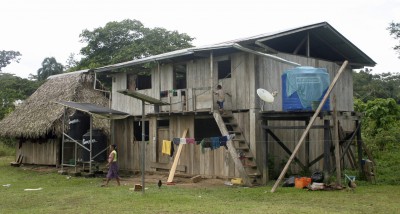

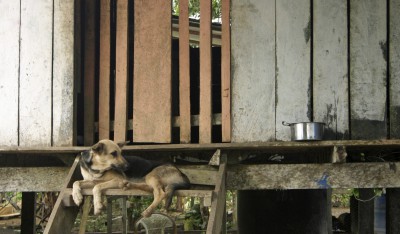 We are given a demonstration of how cassava (aka
We are given a demonstration of how cassava (aka
tapioca or manioc) is planted, grown, harvested, grated, squeezed dry and made
into a large pancake-like bread that is then cooked over an open fire. From
ground to griddle!


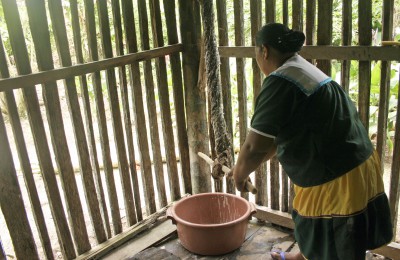

We eat it with pineapple marmalade. Besides cassava,
the Siona people in this village grow chili, cacao, coffee, tree tomatoes (a
palm tree fruit), bananas, potatoes (there are dozens of varieties of potatoes
in Ecuador), beans, mangoes and papayas and have chickens.
- Comments(0) https://travels.insidestory.dk/?p=17
3 – Rainforest routine: biodiversity at every turn
Ecuador Posted on 06 Apr, 2018 19:55 We spend the next few days in the jungle, either cruising
We spend the next few days in the jungle, either cruising
slowly along the river and scanning the sky, the shoreline, the trees and the
water for birds, mammals, fish, reptiles, and insects, or walking in the
rainforest during the day or night. Whether it is day or night, and whether we
are on water or on land, it is immensely satisfying to experience the lush
verdure of the rainforest and to hear the constant symphony of birds, cicadas,
and monkeys. It is altogether quite overwhelming. 
Already on our first day, more than a full page in my
diary gets filled up with the list of the different species we see. Our
adventures begin at sunrise with a ride in the canoe. The morning sun reveals a
myriad of bird life, from tiny hummingbirds (black-throated mango) to groups of
bizarre-looking, clumsy Hoatzin. We see oropendola and their nests. These birds
weave drop-like nests that hang like Christmas decorations from acacia tree
branches. Both the males and the females contribute to building the nests. We
also spot similar nests that are not as pendulous. They are built by
yellow-rumped cacique and are clumped on very thorny palms so no predators can
crawl up to them. We also see a yellow-handed
titi monkey. 
After breakfast on the first day, we go for a walk in
the rainforest and learn about the uses or dangers of the various plants, such
as curare (for dart poison) and quinine (for treating malaria). We also see
lots of interesting spiders, caterpillars, butterflies, ants, frogs, toads, and
orchids.
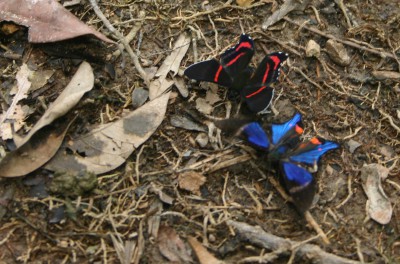
Some larvae travel up the tree in a group to feed then
back down to bed down for the night. They weave a collective thin covering to
protect themselves, but if they are not home by bedtime, the others will not
let them in. Instead, the latecomers will probably end up as prey. 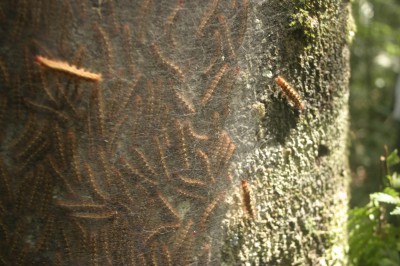
Many animals are experts at camouflage so it is a good
thing we have our guide Luis with us to spot the nearly invisible. Can you see
the stick insect in the photo below? Can you see two? A green male is mating a
somewhat larger brown female that looks exactly like a twig. 
We spend our afternoon on the water and see squirrel
monkeys, owl monkeys and birds, birds, birds. I won’t bore you with the list of
about 40 species (!) of hawks, falcons, kingbirds, kingfishers, vultures,
flycatchers, macaws, tanagers, herons, jays and so on that we see this
afternoon. Suffice to say that we see new things at every turn. 
And so the days go watching wildlife. In addition to
what we saw the first day we see countless more birds, including toucans,
parrots and ibis, another river dolphin, a furry-tailed saki monkey, capuchin
monkeys, iridescent butterflies that flap gently in the air like fairy
ballerinas, fireflies, fruit bats, a caiman and a three-toed sloth. Did you that
know that sloths – three-toed sloths in particular – are actually kind of
greenish? They have a complex symbiotic relationship with sloth moths and algae
that grow in their hair.

On one magical evening, we go for a ride in the canoe
to enjoy the sunset in the lagoon. The water level varies up to eight metres
from dry to wet season.

The partly submerged macrolobium trees, that are
reminiscent of African baobab trees, lend an otherworldly appearance to the
scene. As the sun dips towards the horizon everything turns orange. 
My photographs cannot capture the many birds,
half-hidden monkeys or flitting fireflies. Neither can they do justice to how
it actually feels to be here with the
muggy warmth, the symphony of sounds day and night, and the smells of the humid
earth, plants and fragrant flowers.

- Comments(0) https://travels.insidestory.dk/?p=18
2 – Journey into the jungle
Ecuador Posted on 04 Apr, 2018 19:12A short flight from Quito brings us to the less-than-exciting
oil industry town Lago Agrio. Then we drive for about two hours before reaching
the spot where we board the motorised canoes that will bring us deep into the
jungle in Cuyabeno Reserve. With its astounding biodiversity the seasonally flooded rainforest in
this reserve is a delight for anyone even mildly interested in nature. 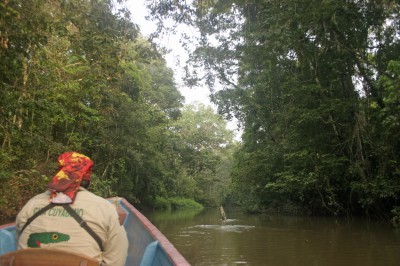
A wall of green greets us on both sides as we glide on
the river for an enchanting 4-5 hours. Palms and other trees, epiphytes, vines
and flowers compete for light and nutrients. Birds cheep and squawk, monkeys
call, and cicadas sing.

In the river, we see two elegant river dolphins that
swim synchronously and make sneezing sounds when they come up for air. I think
I also see the back of a river otter by the riverbank. I am not sure, but what
else could it be with such a sleek hairy back?
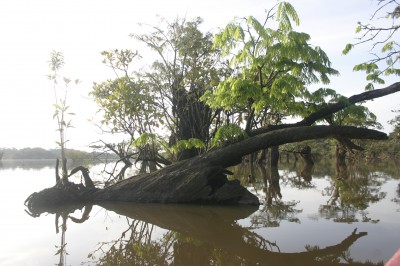
In the forest, a two-toed sloth chills out far above
us while Columbian red howler monkeys, white-bellied spider monkeys and
black-mantled tamarins peer down at us from their lofty perches. Our amazing local
guide Luis with vision like a hawk points out a tidy row of four snoozing short-nosed bats the size of thumbnails clinging to the underside of a leaf, a
non-poisonous rusty whipsnake, and an emerald lizard. 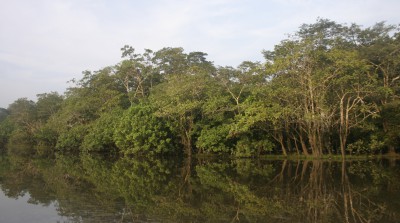
The number of bird species we see on this, our first
river trip, is also impressive and includes the near-threatened, large and
beautiful harpy eagle, turkey vultures, heron-like anhingas with their
snakelike necks, and noisy speckled chachalacas. 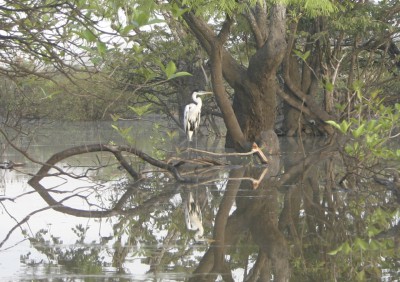
As we glide along the river that twists and bends, new
vistas constantly open up. It seems to go on forever. I cannot help wondering
what early explorers thought when they first discovered this seemingly endless
cornucopia of living beings, this dense and mysterious jungle with all its
animal sounds. 
After arriving and settling in at Siona Lodge, our lovely jungle home for the next few days, we go
for an evening walk in the forest. In the light of a flashlight, we see a
tarantula lying in wait for its next victim, a leaf cutter ant highway packed
with industrious ants carrying their green burdens, colourful frogs, a scorpion
spider, which is neither a scorpion nor a spider, and other interesting creepy
crawlies. Neat stuff! 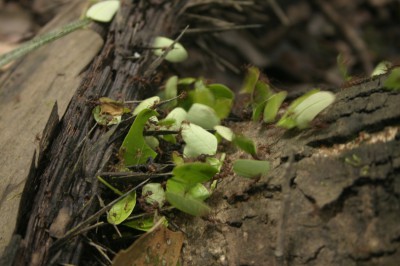
- Comments(0) https://travels.insidestory.dk/?p=19

